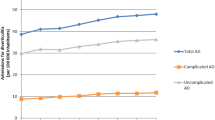Abstract
Background
Epidemiological studies in Western countries have documented an increase of hospitalizations for acute diverticulitis (AD) but Italian evidence is scarce. The aim of the present study was to analyse the trend in hospitalization for AD, including in-hospital mortality, in Italy from 2008 to 2015.
Methods
Through the Italian Hospital Information System of the National Health System, we identified diverticulitis of the colon as a discharge diagnosis. Age- and gender-specific rates of hospitalization for AD were assessed.
Results
174,436 hospitalizations were identified with an increasing rate in 2008–2015 from 39 to 48 per 100,000 inhabitants (p < 0.001). The rate of hospitalization was higher for women, but the increasing trend over time was even more pronounced among men (mean increase per year 3.9% and 2.1% among men and women, respectively) (p < 0.001). The increased rate of hospitalization was accounted for by patients less than 70 years old, especially those under 60. In contrast, the hospitalization rate for older patients (age ≥ 70 years) was higher but remained unchanged during the study period. The number of patients with one hospital admissions was significantly higher than the number of patients with at least two hospitalizations (p < 0.001) and both groups showed a significant and comparable increase year by year. The overall in-hospital mortality rate increased from 1.2 to 1.5% (p = 0.017). More specifically, the increase was observed in patients at their first hospitalization [from 1 to 1.4% (mean increase per year of 3%, p = 0.003)]. An increase in mortality was most evident among women (from 1.4 to 1.8% p = 0.025) and in older patients [age 70–79 years from 1.2 to 1.7% (p = 0.034), ≥ 80 years from 2.9 to 4% (p = 0.001)].
Conclusions
In Italy, between 2008 and 2015, the rate of hospitalization for AD has been constantly increasing due to the hospitalization of younger individuals, especially men. There was a significant increase of in-hospital mortality especially among women, elderly and during the first hospitalization. These findings suggest the need for increased awareness and clinical skills in the management of this common condition.





Similar content being viewed by others
References
Stollman N, Raskin JB (2004) Diverticular disease of the colon. Lancet 363:631–639
Shahedi K, Fuller G, Bolus R et al (2013) Long-term risk of acute diverticulitis among patients with incidental diverticulosis found during colonoscopy. Clin Gastroenterol Hepatol 11:1609–1613
Peery AF, Dellon ES, Lund J et al (2012) Burden of gastrointestinal disease in the United States: 2012 update. Gastroenterology 143:1179–1187
Kang JY, Hoare J, Tinto A et al (2003) Diverticular disease of the colon—on the rise: a study of hospital admissions in England between 1989/1990 and 1999/2000. Aliment Pharmacol Ther 17:1189–1195
Jeyarajah S, Papagrigoriadis S (2008) Diverticular disease increases and effects younger ages: an epidemiological study of 10-year trends. Int J Colorectal Dis 23:619–627
Etzioni DA, Mack TM, Beart RW Jr, Kaiser AM (2009) Diverticulitis in the United States: 1998–2005: changing patterns of disease and treatment. Ann Surg 249:210–217
Nguyen GC, Sam J, Anand N (2011) Epidemiological trends and geographic variation in hospital admissions for diverticulitis in the United States. World J Gastroenterol 17:1600–1605
Paterson HM, Arnott ID, Nicholls RJ et al (2015) Diverticular disease in Scotland: 2000–2010. Colorectal Dis 17:329–334
Wheat CL, Strate LL (2016) Trends in hospitalization for diverticulitis and diverticular bleeding in the United States from 2000 to 2010. Clin Gastroenterol Hepatol 14:96–103
Talabani A, Lydersen S, Endreseth BH, Edna TH (2014) Major increase in admission- and incidence rates of acute colonic diverticulitis. Int J Colorectal Dis 29:937–945
Bharucha AE, Parthasarathy G, Ditah I et al (2015) Temporal trends in the incidence and natural history of diverticulitis: a population-based study. Am J Gastroenterol 110:1589–1596
Cuomo R, Barbara G, Pace F et al (2014) Italian consensus conference for colonic diverticulosis and diverticular disease. United Eur Gastroenterol J 2:413–442
Binda GA, Cuomo R, Laghi A et al (2015) Italian Society of Colon and Rectal Surgery. Practice parameters for the treatment of colonic diverticular disease: Italian Society of Colon and Rectal Surgery (SICCR) guidelines. Tech Coloproctol 19:615–626
StataCorp (2013) Stata statistical software: release 13. StataCorp LP, College Station
Masoomi H, Buchberg B, Nguyen B, Tung V, Stamos MJ, Mills S (2011) Outcomes of laparoscopic versus open colectomy in elective surgery for diverticulitis. World J Surg 35:2143–2148
Simianu VV, Fichera A, Bastawrous AL et al (2016) Number of diverticulitis episodes before resection and factors associated with earlier interventions. JAMA Surg 151:604–610
Vather R, Broad JB, Jaung R, Robertson J, Bissett IP (2015) Demographics and trends in the acute presentation of diverticular disease: a national study. ANZ J Surg 85:744–748
Bollom A, Austrie J, Hirsch W et al (2017) Emergency Department burden of diverticulitis in the USA, 2006–2013. Dig Dis Sci 62:2694–2703
Kyle J, Adesola AO, Tinckler LF, de Beaux J (1967) Incidence of diverticulitis. Scand J Gastroenterol 2:77–80
Janes S, Meagher A, Frizelle FA (2005) Elective surgery after acute diverticulitis. Br J Surg 92:133–142
Chapman JR, Dozois EJ, Wolff BG, Gullerud RE, Larson DR (2006) Diverticulitis: a progressive disease? Do multiple recurrences predict less favorable outcomes? Ann Surg 243:876–830
Ritz JP, Lehmann KS, Frericks B, Stroux A, Buhr HJ, Holmer C (2011) Outcome of patients with acute sigmoid diverticulitis: multivariate analysis of risk factors for free perforation. Surgery 149:606–613
Funding
No source of funding has been provided.
Author information
Authors and Affiliations
Corresponding author
Ethics declarations
Conflict of interest
The authors declare that they have no conflict of interest.
Ethical approval
This article does not contain any studies with human partecipants performed by any authors.
Informed consent
For this type of study formal consent is not required.
Rights and permissions
About this article
Cite this article
Binda, G.A., Mataloni, F., Bruzzone, M. et al. Trends in hospital admission for acute diverticulitis in Italy from 2008 to 2015. Tech Coloproctol 22, 597–604 (2018). https://doi.org/10.1007/s10151-018-1840-z
Received:
Accepted:
Published:
Issue Date:
DOI: https://doi.org/10.1007/s10151-018-1840-z




